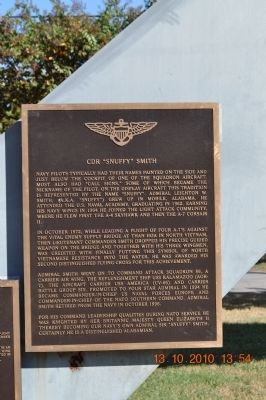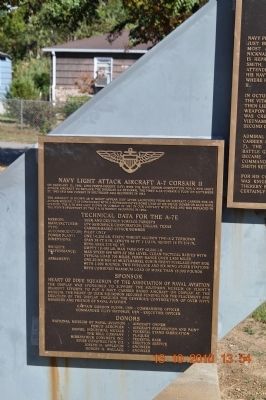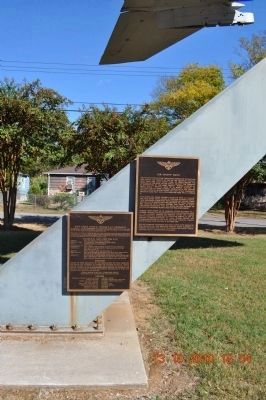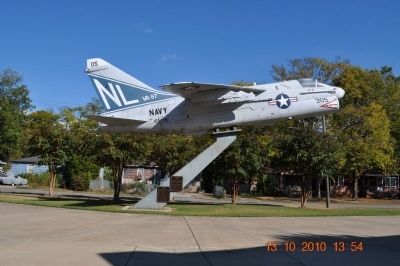Birmingham in Jefferson County, Alabama — The American South (East South Central)
CDR "Snuffy" Smith
Navy Light Attack Aircraft A-7 Corsair II
Navy pilots typically had their names painted on the side and just below the cockpit of one of the squadron aircraft. Most also had "Call Signs," some of which became the nickname of the pilot. On the display aircraft this tradition is represented by the name "Snuffy." Admiral Leighton W. Smith (A.K.A. "SNUFFY") grew up in Mobile, Alabama. He attended the U.S. Naval Academy, graduating in 1962. Earning his Naval wings in 1964 he joined the light attack community, where he flew first the A-4 Skyhawk and then the A-7 Corsair II.
In October 1972, while leading a flight of four A-7's against the vital enemy supply bridge at Than Hoa in North Vietnam, then Lieutenant Commander Smith dropped his precise guided weapon on the bridge and together with his three wingmen, was credited with finally putting this symbol of North Vietnamese Resistance into the water. He was awarded his second Distinguished Flying Cross for this achievement.
Admiral Smith went on to command attack squadron 86, a carrier air wing, the Replenishment Ship USS Kalamazoo (AOR-7), the aircraft carrier USS America (CV-66) and Carrier Battle Group Six. Promoted to four star admiral in 1994 he became Commander-in-Chief US Naval Forces Europe and Commander-in-Chief of the NATO Southern Command. Admiral Smith retired from the Navy in October 1996.
For his command leadership qualities during NATO service he was knighted by her Britannic Majesty Queen Elizabeth II thereby becoming our Navy's own Admiral Sir "Snuffy" Smith. Certainly he is a distinguished Alabamian.
(Second Plaque):
Navy Light Attack Aircraft A-7 Corsair II On February 11, 1964, Ling-Temco-Vought (LTV) won the Navy design competition for a new light attack aircraft to replace the Douglas A-4 Skyhawk, The First A-7A Corsair II flew on September 27, 1965 and saw combat in Southeast Asia beginning in 1967.
The Aircraft is shown as it might appear just after launching from an aircraft carrier for an attack mission. It is configured with a representative bomb load of six 500 lb. bombs on each wing station. The A-7E was last flown in combat in 1991 in our conflict with Iraq and was replaced in the Navy's inventory by the F/A-18 Hornet beginning in 1993.
Technical Data for the A-7E
Mission: Seek and destroy surface targets
Manufacture: LTV Aerospace Corporation, Dallas, Texas
Accommodation: Pilot Only
Power Plant: One 14,250 lb, static thrust Allison TF41-A-2 Turbofan
Dimension: Span 38 Ft. 9 In. Length 46 Ft. 1 1/2 In. Height 16 Ft. 3/4 in.
Wing area 375 Sq. Ft.
Weighs: Empty 19,490 Lb. max take-off 42,000Lb.
Performance: Max speed 698 MPH at sea level, clean tactical radius with typical load 700 miles, ferry range over 2,800 miles.
Armament: One 20-MM M61-A1 Multi-barrel gun in front Fuselage Port with 1,000 rounds, two fuselage and six wings store stations with combined maximum load of more than 15,000 pounds
Sponsor
Heart of Dixie Squadron of the Association of Navy Aviation
The display was sponsored to support the Southern Museum diligent efforts to put a navy carrier based aircraft on display at the museum. The Heart of Dixie Squadron Secured Funding for the erection of the display through the generous contributions of over fifty members and friends of Naval Aviation. Captain Gordon Flynn, USN- Commanding Officer Commander Cliff Hathway, USN Executive Officer Donors National Museum of Naval Aviation -Aircraft Owner Pemco Aeroplex- Aircraft Preparation and Paint Daniel Industrial Metals - Pedestal Stand Fabrication The Bell Company - Plaques Kirkpatrick Concrete Inc. - Pedestal Base Rives Construction Co. - Erection Service Joseph H. Appleton - Engineer Robert H. Wallace - Engineer
Topics and series. This historical marker is listed in this topic list: Air & Space. In addition, it is included in the Valor in Aerial Operations series list. A significant historical month for this entry is February 1904.
Location. 33° 33.808′ N, 86° 44.26′ W. Marker
is in Birmingham, Alabama, in Jefferson County. Marker is on 73rd Street North. Touch for map. Marker is at or near this postal address: 4343 73rd Street North, Birmingham AL 35206, United States of America. Touch for directions.
Other nearby markers. At least 8 other markers are within 2 miles of this marker, measured as the crow flies. East Lake Community (approx. half a mile away); Howard College (approx. 0.8 miles away); Ruhama Baptist Church (approx. 0.9 miles away); East Lake Park (approx. 0.9 miles away); 1963 Church Bombing Victims (approx. 1.1 miles away); Forrest Camp No. 1435 (approx. 1.2 miles away); United Confederate Veterans (approx. 1.2 miles away); History of the 117th Tactical Reconnaissance Wing (approx. 1.3 miles away). Touch for a list and map of all markers in Birmingham.
Credits. This page was last revised on November 25, 2023. It was originally submitted on February 4, 2012, by Sandra Hughes Tidwell of Killen, Alabama, USA. This page has been viewed 1,582 times since then and 49 times this year. Last updated on May 28, 2015, by J. Makali Bruton of Accra, Ghana. Photos: 1, 2, 3, 4. submitted on February 4, 2012, by Sandra Hughes Tidwell of Killen, Alabama, USA. • Andrew Ruppenstein was the editor who published this page.



